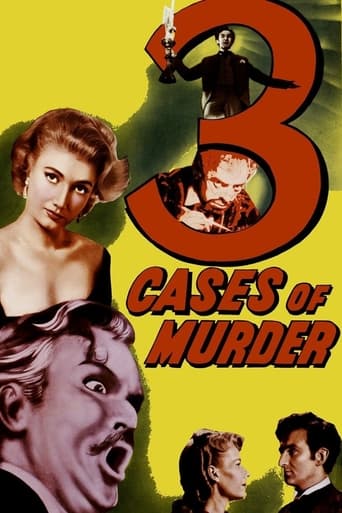Colin_Sibthorpe_II
I love the way Eamonn Andrews, in his introduction, saunters over to the mantelshelf, picks up the cigarettes and lights one! How better to make him seem to be acting naturally in the 50s?Story 1 is intriguing and disturbing but a bit too long. Some of the flat spots add to the suspense and atmosphere, but some are just flat spots.Agatha Christie has spoiled us for the likes of Story 2. I'm sure most people see the twist coming a mile off. The only sub-standard section.A great actor and a master storyteller come together to produce something special in Story 3, marginally better than Story 1 and thus best of the bunch.
ianlouisiana
Plaudits to "Talking Pictures TV" for putting this criminally - neglected British gem into their late - night schedules. One of the later "portmanteau" works, anchored by the urbane Mr Eamonn Andrews who was huge on English television in the mid 1950s,"Three cases of murder" featured the extraordinary talents of Alan Badel in all three segments. The first - directed by Wendy Toye - is one of the cinema's eeriest experiences.Much of it shot in deep focus and at weird angles and with intense acting by Mr Badel as the ghost of a painter whose work is on display at a small museum. This also features Eddie Byrne as a barking mad naturalist called "Snyder"whose hobby is pinning insects to pieces of card.His latest acquisition(human) is several times referred to as "Snyder's trophy" - an allusion that may well be lost on 21st century viewers but would not have escaped a contemporary audience. I found it very disconcerting and a minor triumph for director and actors both. The second features the amiable John Gregson in a rare non - military role as one of a pair of chums inseparable since school who both go up to Cambridge(Trinity College) and from there to the advertising industry before falling for the same woman with entirely predictable results. THe main interest for modern viewers is the entirely civilised way the (rather ancient) undergraduates behave at their "May Ball" compared to their successors. Finally Orson Welles stars as the arrogant Foreign Secretary who belittles the splendid Alan Badel(A Welsh Firebrand M.P.) on the floor of the House and soon wishes he hadn't. The expected amount of scenery is chewed and as long as the cheque cleared I suspect Welles was a happy man. Do catch this if you possibly can.Hardly anyone will have heard of it and it really is worth the effort. In particular,the Wendy Toye episode is required viewing for serious students of British movies.
gavin6942
Three stories of murder and the supernatural. In the first, a museum worker is introduced to a world behind the pictures he sees every day. Second, when two lifelong friends fall in love with the same woman and she is killed, they are obvious suspects. Is their friendship strong enough for them to alibi each other? Third, when a young politician is terribly hurt by the arrogant Secretary for Foreign Affairs Lord Mountdrago, he uses Mountdrago's dreams to get revenge.Orson Welles received top billing, but he appears only in "Lord Mountdrago." According to Patrick Macnee, who had a supporting role, Welles began making suggestions to director George More O'Ferrall throughout the first day of filming, and by the third day he had taken over the direction of the entire segment.Does this surprise anyone? Of course Welles would be the star to draw audiences in, and of course he would try to take over the production, because that was very much the sort of chap he was. For better or worse, a film starring Welles was very much a Welles film.As far as anthologies go, this one is not often remembered. And as far as horror anthologies go (if this even counts), it seems all but forgotten, overshadowed by the later Amicus films. I love Amicus, and it is hard to beat them, but surely this film must have been some influence on the later Amicus and Hammer productions.
gridoon2018
All three stories contained within this film have interesting concepts, but they don't quite reach their full potential. The best is the first, directed by a woman (Wendy Toye), mainly for a fantastic (in every sense of the word), hypnotic sequence of two people entering a painting; this story is certainly highly imaginative, but the dialogue does tend to ramble a little. The second story, about two childhood friends and the woman who comes between them, has a good setup, but the big twist is blindingly obvious; to be fair, though, what happens after the big twist is much less so. The third story also has a great concept (a man entering another man's dreams at will), but it goes on too long, and in my opinion Orson Welles is slightly miscast as a victimized character. Alan Badel, who appears as three different characters in all three stories, walks away with the acting honors. **1/2 out of 4.



